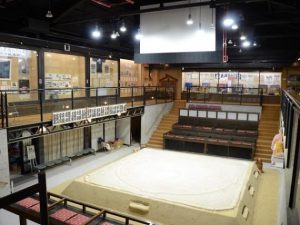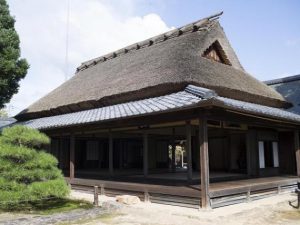Winter has come to Nara.
Morning mist in winter makes up the Nara Park beautiful, but winter also brings us the intense cold.
What can we offer to make you visit and enjoy Nara in spite of this winter chill?
Here comes a new program in which you can enjoy in a warm room!
In this program, you make a kaleidoscope on your own in a lovely cafe “Kaleidoscope cafe Siloam”. Colorful beads, pearls, and other variously shaped parts will make your kaleidoscope unique and original.
You will be amazed at how fascinating it is. It is far beyond the toys we enjoyed in our childhood.
Here’s my experience report of this program.
“Kaleidoscope cafe Siloam” is located in a cozy town at the west end of Todai-ji temple.
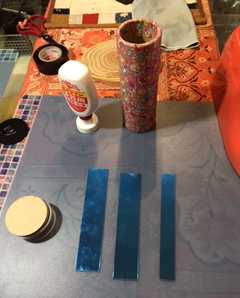
Here are the materials.
The first step is to assemble the inner parts of the kaleidoscope.
Even if you are not so confident in your handicraft skill, you don’t need to worry. The master will steadily instruct and assist you.
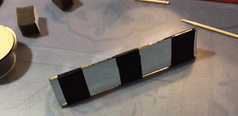
First, I assembled the mirrors which make the central part of the kaleidoscope.
I was not so good at assembling that the master kindly assisted me…
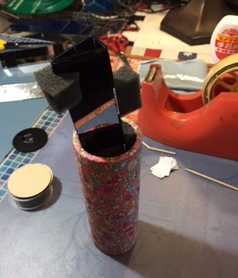
Then, I joined the mirror parts and the tube together, which will make the main body of the kaleidoscope.
This process will affect how the kaleidoscope patterns look. Extra care is needed!

After finishing the main body, I put the beads and other parts into the body, which make the patterns.
However, it was not an easy task to choose from so many beautiful beads, pearls, and other parts!
In case you feel difficulty in choosing, please ask the master and madame for the proper parts.
They will kindly give you good advice!
For those who don’t have enough time, a shorter plan is available, in which you can experience the kaleidoscope making from this phase!
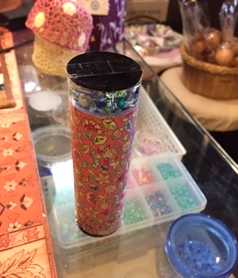
Finished!
Let’s take a glance inside!!
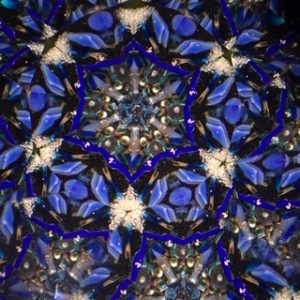
The motif is Nara in Winter!
I can’t help praising myself for the beautiful patterns. They change their expression every time I turn my kaleidoscope.
Because it’s self-made, you can enjoy yourself by guessing which beads or parts compose the patterns.
I want to make another one with different colors!
-300x225-300x225.jpg) After you finished your kaleidoscope, please have a relaxing time with a cup of coffee and its rich aroma.
After you finished your kaleidoscope, please have a relaxing time with a cup of coffee and its rich aroma.
This program includes the fee for one drink!
While enjoying your coffee, you can also appreciate more than 200 artistic kaleidoscopes for sale.
Looking into the ever-changing patterns of the kaleidoscopes is so fun that you might lose track of time.
Talking with the frank madame and master is also fun.
I recommend strolling Todai-ji temple after you leave the cafe.
Daibutsu-den hall is about 10 minutes walk from the cafe, and Nigatsu-do hall is about 15 minutes walk.
Furthermore, you can find Isuien park and the former residence of Irie Taikichi (a photographer who devoted his life to shoot photos of Nara) near the cafe. This cozy town is perfect for strolling around.
Please come and enjoy this experience during winter!
Please make a reservation for this program at
http://nara-experience.com/detail/index/349
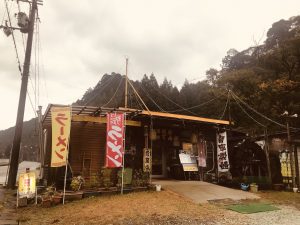 Or at least, that’s how it feels when I visit Yottenka in Yoshino Town. It’s a small, stand-alone wooden shop, attached to old truck beds, and with a wooden water wheel in front. Inside is the kind of warm atmosphere that is difficult for visitors to Japan to discover on their own. Shelves of comic books, a box of local fruit, a counter facing the kitchen, and a well-worn center table. In addition to standard flavors like miso, soy sauce, and salt ramen, they have a special sesame ramen, a spicy beansprout ramen, and even chilled ramen for hot summer days.
Or at least, that’s how it feels when I visit Yottenka in Yoshino Town. It’s a small, stand-alone wooden shop, attached to old truck beds, and with a wooden water wheel in front. Inside is the kind of warm atmosphere that is difficult for visitors to Japan to discover on their own. Shelves of comic books, a box of local fruit, a counter facing the kitchen, and a well-worn center table. In addition to standard flavors like miso, soy sauce, and salt ramen, they have a special sesame ramen, a spicy beansprout ramen, and even chilled ramen for hot summer days.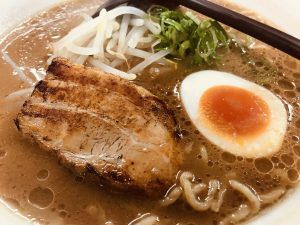 When I went there for lunch the other day, I ordered the miso ramen and gyoza set. The noodles seemed to absorb the flavorful miso soup, as did the slice of pork, which slowly softened as I saved it for last. The gyoza came out hot and fresh, smelling of garlic as I dipped each bite into the spicy red oil. I said “gochisosama” to kind old man and exited the shop with a full stomach.
When I went there for lunch the other day, I ordered the miso ramen and gyoza set. The noodles seemed to absorb the flavorful miso soup, as did the slice of pork, which slowly softened as I saved it for last. The gyoza came out hot and fresh, smelling of garlic as I dipped each bite into the spicy red oil. I said “gochisosama” to kind old man and exited the shop with a full stomach. 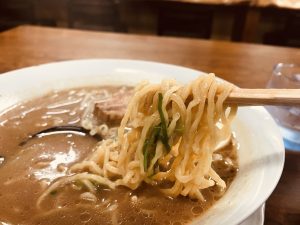
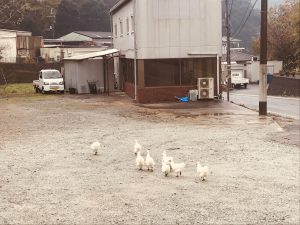

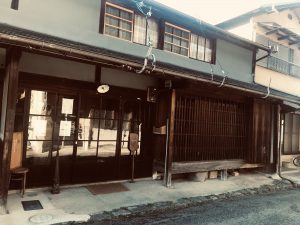 The city of Uda covers a vast amount of space in southern Nara prefecture, and includes mountains, rice fields, and many other crops. In the heart of its Oh-Uda area is a large souvenir shop, an onsen hot spring bath, and a traditional townscape. There are some unique restaurants and cafes in this townscape, and I had the pleasure of visiting one just the other day.
The city of Uda covers a vast amount of space in southern Nara prefecture, and includes mountains, rice fields, and many other crops. In the heart of its Oh-Uda area is a large souvenir shop, an onsen hot spring bath, and a traditional townscape. There are some unique restaurants and cafes in this townscape, and I had the pleasure of visiting one just the other day. 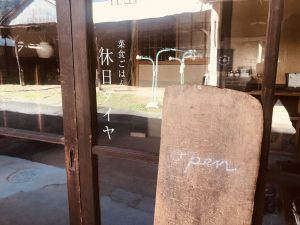 Kyujitsu-Daiya, or “holiday schedule”, is a vegan cafe and restaurant located in that townscape. In addition to not using any animal products, they make the effort to use organic vegetables, and even organic coffee. It is a warm and cozy environment located in a traditional Japanese house, with a number of quiet, unique spots for guests to sit and eat.
Kyujitsu-Daiya, or “holiday schedule”, is a vegan cafe and restaurant located in that townscape. In addition to not using any animal products, they make the effort to use organic vegetables, and even organic coffee. It is a warm and cozy environment located in a traditional Japanese house, with a number of quiet, unique spots for guests to sit and eat. 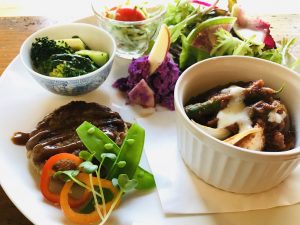 I sat in a floor seat facing the win dow of a small garden, and after I’d read a few pages in my book, the owner brought out my lunch and explained each item. It included a hamburger patty made from garbanzo beans and lotus root, a sweet potato salad made from apples, tofu okara, and soy milk mayonnaise, a bowl of brown rice, and soup made from homemade miso. It’s the kind of meal that makes you want to take your time and enjoy every bite.
I sat in a floor seat facing the win dow of a small garden, and after I’d read a few pages in my book, the owner brought out my lunch and explained each item. It included a hamburger patty made from garbanzo beans and lotus root, a sweet potato salad made from apples, tofu okara, and soy milk mayonnaise, a bowl of brown rice, and soup made from homemade miso. It’s the kind of meal that makes you want to take your time and enjoy every bite. 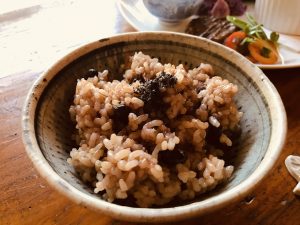
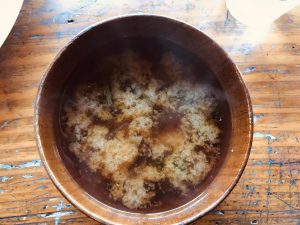 After my lunch, I had a hot cup of hot organic coffee while I sat by the window and continued reading. In a more touristy location, I might not have been able to take my time and enjoy such a quiet place. Homemade miso, local vegetables, I felt like I had a nice chance to appreciate the beauty the countryside has to offer, especially in southern Nara.
After my lunch, I had a hot cup of hot organic coffee while I sat by the window and continued reading. In a more touristy location, I might not have been able to take my time and enjoy such a quiet place. Homemade miso, local vegetables, I felt like I had a nice chance to appreciate the beauty the countryside has to offer, especially in southern Nara.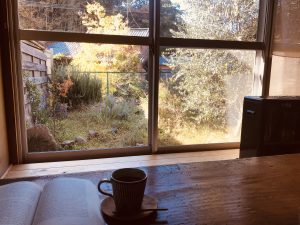
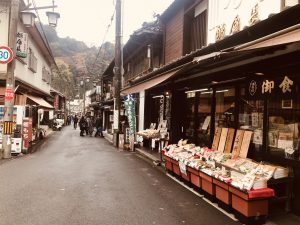
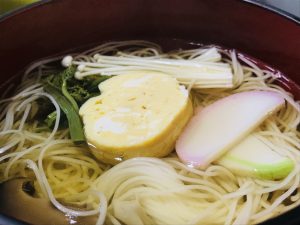
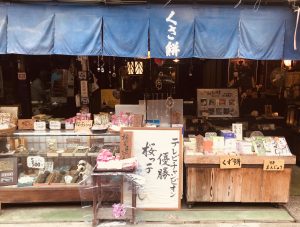
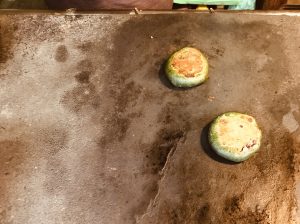
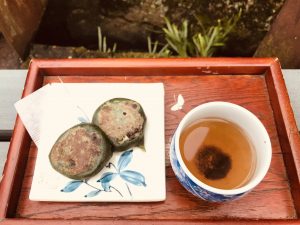
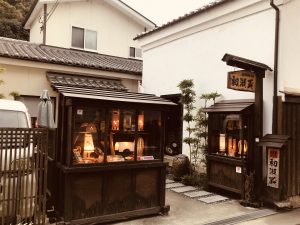
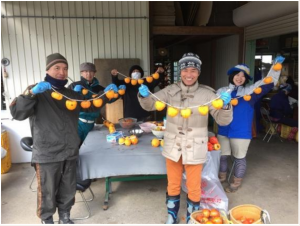 Fields of persimmon trees. Farms. Big, slow clouds, and some nice wind. That was what I expected on my first visit to Shimoichi Town last weekend, and well, that was what we had. My only prior knowledge of this peaceful, mountain town was what I had translated for the Anpo Persimmon making experience. We will have the English version up soon, but for now,
Fields of persimmon trees. Farms. Big, slow clouds, and some nice wind. That was what I expected on my first visit to Shimoichi Town last weekend, and well, that was what we had. My only prior knowledge of this peaceful, mountain town was what I had translated for the Anpo Persimmon making experience. We will have the English version up soon, but for now, 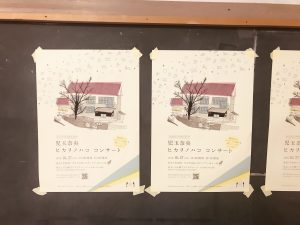
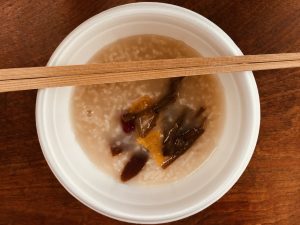
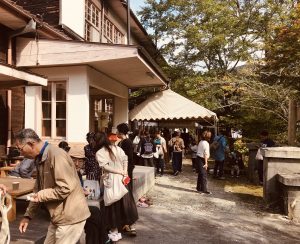
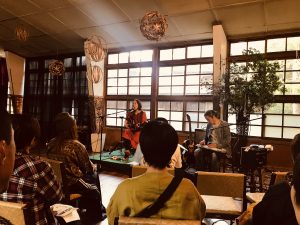 Sitting alone on the stage, she was a fresh, new presence in a school some might have considered forgotten. For me, the beauty of this event was how it found a new use (music) for a former school, and through this, introduced local food and culture to the many visitors who came that day. In addition to helping preserve the culture, it brought people together in an area with fewer and fewer residents. It was truly a pleasure to be a part of it.
Sitting alone on the stage, she was a fresh, new presence in a school some might have considered forgotten. For me, the beauty of this event was how it found a new use (music) for a former school, and through this, introduced local food and culture to the many visitors who came that day. In addition to helping preserve the culture, it brought people together in an area with fewer and fewer residents. It was truly a pleasure to be a part of it.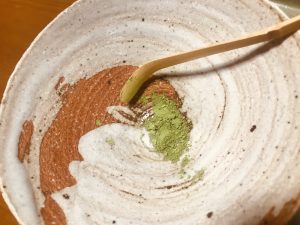
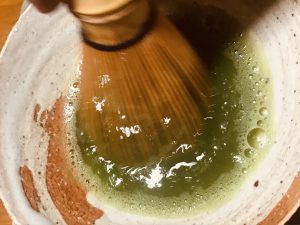
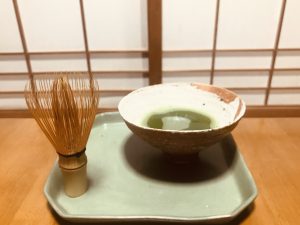
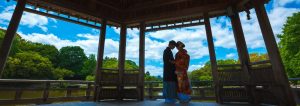











-300x225-300x225.jpg) After you finished your kaleidoscope, please have a relaxing time with a cup of coffee and its rich aroma.
After you finished your kaleidoscope, please have a relaxing time with a cup of coffee and its rich aroma.